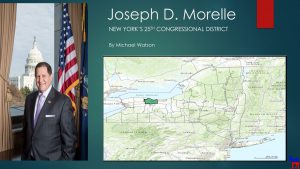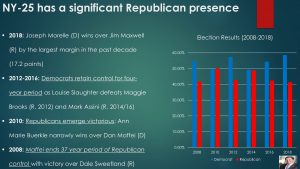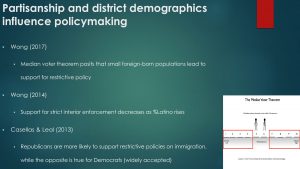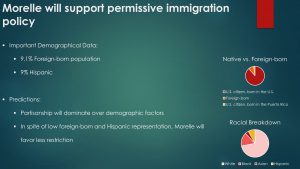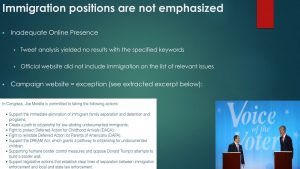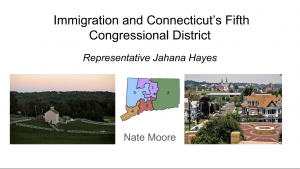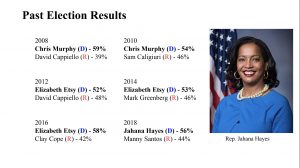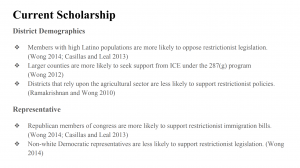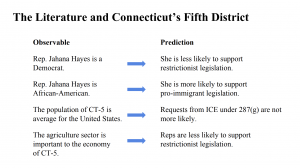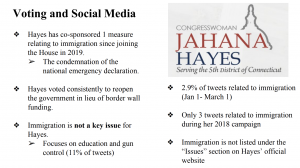Slide 1:
This slide shows the shift in the district. Republican Paul Gosar has been the representative for this district since 2013. Prior to that, he served as the representative for Arizona District 1, where he ran as a tea party candidate. Prior to Gosar the district was served by Ed Pastor, the first Mexican American to represent Arizona. Pastor was a strong democrat who served the district from 2003-2013, winning with over 60% of the vote in each election. However, after the 2010 census, there was significant redistricting. The old district 4 essentially became district 7, and the new district 4 encompassed mostly Western Arizona. This district is now the most rural and the most republican district in Arizona. This district is also 19% Hispanic and 8% foreign born with a lower income than the national average.
Slide 2:
This slide summarizes the relevant literature of how local electorate context and the characteristics of a congressional member affects the support of a district’s representative for restrictive immigration policies. Two key factors: partisanship and demographics emerge as elements in the type of legislation that the representative ultimately supports. Republican representatives are more likely to support restrictive legislation than democrats, and those representing more Republican districts are also more likely to support restrictive legislation (Wong 2014; Casillas and Leal 2013). Casillas and Leal argue this is the only consistent factor. Additionally demographics matter. When a district has a higher proportion of foreign born individuals, Wong (2017) finds that the representative is less likely to vote for restrictive immigration policy. Additionally, an increased Latino population is associated with votes for less restrictive immigration policy (Wong 2014). However, when the Hispanic population is rapidly increasing in a republican district, this leads to more restrictive immigration policy (Ramakrishnan and Wong 2010.)
Slide 3:
This slide outlines based on the literature above, what might we expect the views of the representative of Arizona’s fourth congressional district to be on immigration. There are a few key findings. First, based on partisanship both of the representative and the district, since Paul Gosar is a Republican and the district leans heavily Republican, we would expect Gosar to support restrictive immigration policy. Only eight percent of the district is foreign born, so we would also anticipate more restrictive views from the district’s representative on immigration policy. The district is slightly more Hispanic than the national average (19.2% in AZ4 versus 17% nationally), so we would initially expect more moderate or permissive views on immigration policy. However, when we keep in mind that the Hispanic population is growing in an overwhelmingly Republican district, it follows that the representative for the district would vote in favor of restrictive immigration policy.
Slide 4:
This slide shows that not only does Paul Gosar support restrictive immigration as predicted, it is actually one of his central policy platforms. He has sponsored or co-sponsored 27 bills on the topics of immigrants and “aliens”, all of which seek to limit their presence in the country, harshen penalties, and limit their access to US resources. Almost half of his twitter use is about immigration, making references to crime and supporting the building of a wall. Immigration is also listed as one of the top three “priorities” that Gosar has on his website. These views are highly consistent with the current views of the Republican party. Additionally, Gosar’s support of these issues rely highly on language invoking national security and the interests of Arizonan’s who live near the border, implying it could be a highly salient issue for his constituency. It is unclear how these views impact his support among Hispanic voters in the district, but regardless, Gosar won every country in his district.
